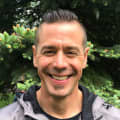The exercise ball is commonly used for back pain rehabilitation and as an aid in building back strength, stability and flexibility.
Working out while staying balanced on the exercise ball requires enhanced engagement and coordination of the many muscles that connect in and around your spine.
An exercise ball goes by many names, including gym ball, stability ball, Swiss ball, or physio ball.
An exercise call can be an invaluable tool for rehabilitating back pain.
In This Article:
- Exercise Ball Therapy for Lower Back Pain Relief
- Commonly Prescribed Exercise Ball Workouts for Back Pain
- Exercise Ball Exercises to Build Core Body Strength
- Video: Why is Exercise Important for Lower Back Pain?
How Exercise Ball Exercises reduce Back pain
Using the exercise ball is effective in helping reduce back pain and rehabilitate the back through the following mechanisms:
Small range of movements reduces pain
It is generally understood that the type of spinal movement induced by using the exercise ball (small range, adjustment of balance) tends to help reduce pain by stimulating the body to produce increased amounts of natural pain inhibitors.
Proprioception aids in balance and stability
The instability of the exercise ball means that your body’s proprioception to balance on it is challenged. The term proprioception refers to the body’s awareness of where an extremity like a hand or foot is in relationship to space.
The instability of the exercise ball provides the body with constant opportunities to evaluate its orientation in space, developing and training the body's natural awareness.
Building proprioception provides your body with increased balance and stability.
Builds and maintains correct posture
Staying balanced on the exercise ball while doing movements requires coordination of core muscle groups in and around your spine.
These muscles are engaged to stabilize correct posture and the normal structure of your spine. As these muscles become stronger, they support your spine and reduce stress across your lower back.
Nourishes the spinal discs
A well-planned exercise ball routine is designed to bring movement to the spine in a controlled manner to help keep the discs nourished.
Moving the vertebrae and spinal joints helps nourish the discs in the spine by increasing blood flow around the disc and by causing the water to flow in and out of the disc.
In addition, using an exercise ball is a simple and versatile way to start moving again after a back pain episode.
There are a few disadvantages of exercise balls
Using the exercise ball introduces an element of instability, so there is a potential risk of injury. Potential risks include:
- Added stress on the back (for example, if using poor posture)
- Falling off the exercise ball while doing an exercise
- Overinflating the ball so it bursts
Before starting these types of exercises, see an appropriately trained and licensed spine specialist, such as a physical therapist, occupational therapist, chiropractor, exercise physiologist, or physical medicine and rehabilitation physician (also called a physiatrist).
A spine specialist certified in exercise ball technique is well-suited to develop the right exercise program and provide instruction on correct form and technique.
The exercise program will depend on your specific diagnosis, fitness level, and amount of pain.
Simply sitting on an exercise ball causes constant engagement of the core muscles to remain balanced and centered on the ball.
Introduction to Using an Exercise Ball
As an introduction to exercising on the ball, it is often recommended that you simply sit on the ball for 30 minutes a day and bounce lightly, continually finding and maintaining balance on the ball. You may even want to start with several shorter sessions and work your way up to 30 minutes.
Another recommended first step on the exercise ball is to find a neutral (lordotic) lumbar spine position.
- Slouch slightly on the exercise ball, rounding the lower and upper back
- Begin bouncing lightly on the exercise ball
- Allow the body to automatically find the straightened posture, which promotes staying balanced while continuing to bounce on the exercise ball
This balanced position on the exercise ball is also referred to as the center of gravity, where the upper body is balanced on a stable pelvic base.
Even a slight change in this neutral posture position will change the center of gravity and require a correction to stay on the exercise ball. Your stomach and low back muscles are required to work the entire time to keep this balanced, neutral posture.
The ball should be inflated to a point where it is not too squishy or flat, but also has a slight give so that when you sit on it the top indents or flattens slightly with your weight.
Size matters – here’s how to select the right size of exercise ball for your height.
When Not to Use an Exercise Ball
It is highly recommended that patients work with their spine specialist when considering using an exercise ball to ensure the ball is properly sized and that proper form and technique are learned.
- Exercises should be done in a controlled manner and speed, starting slowly and building confidence.
- The constant use of muscle groups to maintain balance on an exercise ball may lead to quicker than expected fatigue, and patients may find that at least at first, they need to do shorter exercise routines than expected.
- A physician should always be consulted about conditions that can be aggravated by this form of exercise before proceeding.
As with any piece of exercise equipment, the manufacturer's instructions for care and use should always be followed.







